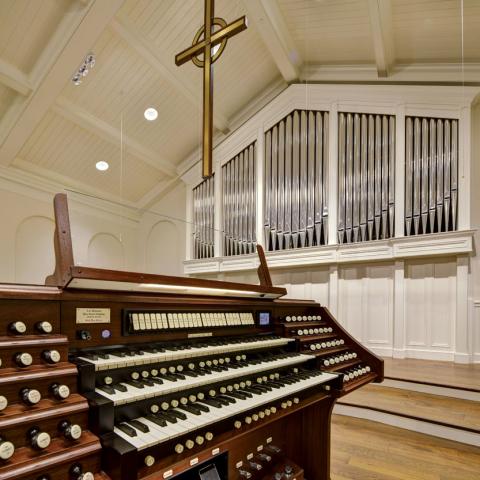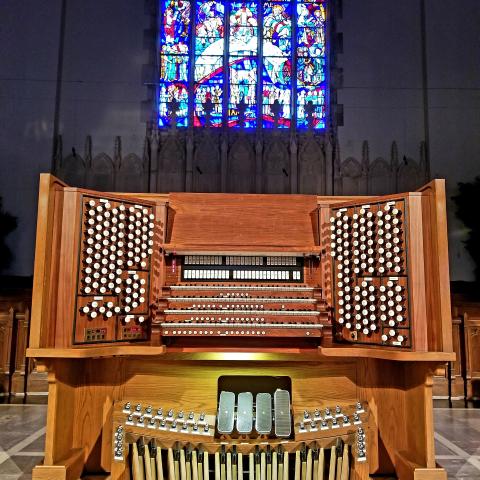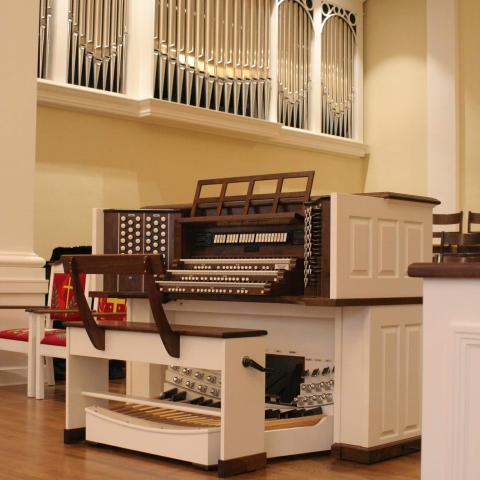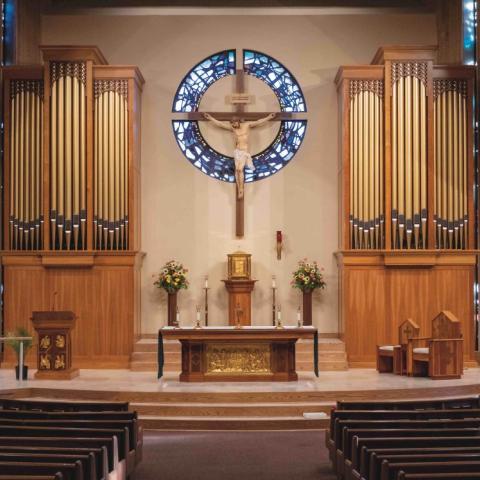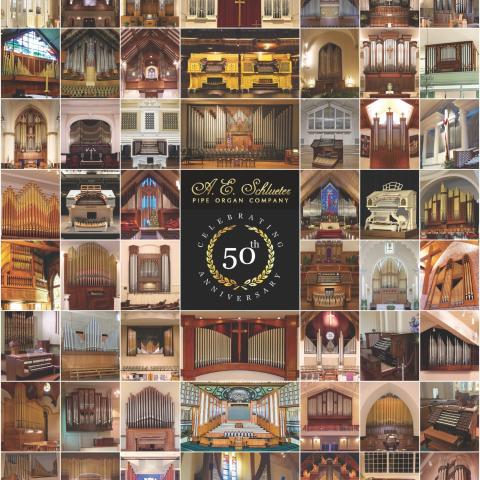A. E. Schlueter Pipe Organ Company, Lithonia, Georgia; Saint Andrew’s Episcopal Church, Fort Pierce, Florida
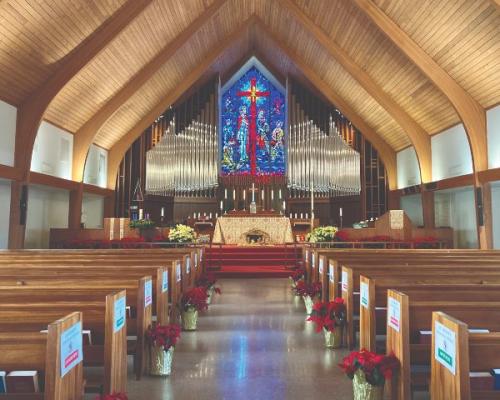
As I contemplated writing this article about the new pipe organ for Saint Andrew’s Episcopal Church in Fort Pierce, Florida, many things came to mind, several of them cathartic and all of them personally important. Fort Pierce is a location where, as they say, I have “roots.” I was born in the Fort Pierce area in 1967, and was baptized at the First United Methodist Church. In the ensuing years, my family would continue to come back to this community to visit, to rest, and for recreation. It was an important enough location to me that when I got married in the early 1990s, I brought my young wife to one of the barrier islands near Fort Pierce for our honeymoon. This area was special to me, and I wanted to share it.
Moving forward to 2022 and a country still in the grip of Covid, I am glad that, in light of the pandemic, the building of this instrument occurred at a time and place that is familiar, and that I was working for a congregation and clergy that are some of the finest people on this planet. One cannot have endured the last couple of years without considering the pandemic and its effects on the world, our houses of worship, and on many of us personally. This church and its people buoyed us. They have offered unyielding prayer, support, and an unbridled excitement for the completion of this project.
The commission to build this instrument started out in a world that was Covid-free. By the time we were taking out the old organ, we were in masks, with travel and work restrictions and navigating a brave new world. In the meantime, we continued our work with a myriad of social, business, and personal interaction changes.
Along with the personal challenges (and losses) that have been endured, we also have had to deal with supply chain and vendor issues. There have been several suppliers and major vendors that were not able to weather this disruptive period and ceased operations. We have been fortunate with our depth of resources, the excellence of our staff, and full order books, that we have been able to navigate this period in a way that not all have been able to do. This is and has been a very real blessing. As I write this, I am hoping that we are in the waning period of the pandemic, but we are still in masks, and there are still many in the hospital from this malady.
How it started
When we were approached to evaluate the original organ at Saint Andrew’s, we arrived to find an instrument that was in a failing condition. We made a detailed study of the entire instrument with its mechanical condition, scaling, and tonality, balanced with the church’s musical needs. We also looked at the organ layout, the chamber spaces, and the acoustics.
The former organ was an electric-action, open-toe instrument that was built in the late 1970s. The organ did have some nice moments and some good materials, but, as a whole, with its stoplist and tonal design, it was not well suited to support the choral and congregational needs of this Episcopal church. In its later years, the organ had been damaged in a hurricane and endured some unfortunate attempts by others to repair, augment, and change it. The organ had a number of older relay components along with a console that had been rebuilt by others with a used solid-state combination system of various ages of materials. Its condition had been further exacerbated by lightning strikes to its systems. The console and relays were not reliable and could not be made so without heroic work that simply could not be justified.
The layout of the original instrument caused multiple tuning and tonal issues. This was due to a Choir division that was double stacked with the main air return of the church in front of this division, the Great division located four feet above the choir loft floor, directly behind the choristers and below a stained-glass window, and the Swell division in a freestanding box in an organ chamber fronted with a fabric grille. All of this conspired to create major tuning issues inter- and intra-divisionally, as well as a lack of tonal focus.
Our plan
We proposed to work with a clean sheet in design that would fully support worship along with a new façade and case to provide visual enhancements to the chancel. With the proximity of the church to the coastline, we chose a façade design that was evocative of the billowed boat sails that one sees in the waters around the church. The center of the case includes quatrefoils and moulding details found in the stained-glass windows from the original church building. The center case features an open top to allow the central window to be seen with minimal occlusion. The façade pipes are built of polished aluminum and include 16′ and 8′ bass pipes of the Pedal and Great divisions.
The design of the new organ moved the divisions and the return ducts, placed a roof over the center division to mitigate the effects of the central stained-glass window, and generally has placed the pipework on a similar thermocline. There are openings behind the façade pipes to allow a free exchange of heat and air to the chamber spaces.
The church and its contractor must be commended for their revisioning of the chancel and renovation of the worship center of the church. Notably, this included the removal of carpet and the installation of marble in the altar area. The choir area was finished with custom tile and individual chairs replacing fixed pews. Not only is the area more functional, it is visually beautiful and aurally supportive to the organ and the choir. This church acoustic gives back to the listener, and it has gotten even better.
The new stoplist was envisioned first and foremost to support the musical needs of this church and its English choral tradition. There has always been a hope to use the music ministry for community outreach, so while focused on the choral and congregational worship needs of the organ, the stoplist is purposely eclectic in design, allowing it to support many different schools of organ and choral music.
As we designed the new organ, we did look at some of the existing pipes. The pipework contained in the old organ was generally of high quality with low cut-ups and an absence of nicks and other voicing techniques that were permanent to the pipes. It was, in a way, raw media waiting to be voiced. As a company, we have never shied away from evaluation of extant pipework for consideration. Equally important is that one should never—I emphasize, never—design an organ around the pipes that are present with this being the only consideration. It was clear to us that some of the pipework, for purposes of stewardship, could and should be considered for reuse as long as it did not compromise the overall tonal design. It was also clear that some pipework would not, and indeed should not, find a home in the new instrument. Our approach was to design the specification and scaling that should be at the church, and only then did we look afresh at the existing pipework to see if it could be recast. The pipes that were reused were revoiced, rescaled, and/or repitched for their new role. Many of these allowed the fiduciary luxury of additional pedal resources and mutations.
The specification is designed around a Great division with a well-developed, leading principal chorus. The design includes a second 8′ Geigen Principal to allow a differing root structure in the chorus or doubling of the 8′ pitch line. The flutes are designed to fold hand in glove with the chorus while maintaining an individual identity and voice for melodic solo lines. The reeds of the Choir-Positiv and Swell are duplexed to the Great.
The Great division is located at the cantilevered façade level of the organ case, which allows the sound to bloom forward of the choir. To help focus the Great division, the Bourdon chest and upper walkboard act as a canopy above the Great to project this division.
The Choir-Positiv division sits in the former central location of the old Great division, and was conceived as a diminutive, dual-natured division. Its design supports text painting under the choir while also supporting the literature bias of an unenclosed Positiv division. With a secondary principal chorus rooted with the 8′ Holzgedeckt and 8′ Erzahler, it acts as a counter chorus voice to the Great and Swell divisions. The 2′ Schweigel and 1-1⁄3′ Quint allow the chorus to have “mixture texture” that is unweighted and some of the first upperwork available in building the organ to its full voice.
The 8′ Erzahler was chosen because it allows a voice that is at one time a diminutive string while at another time a soft accompanimental voice that can be broadened with the 8′ flute line. It is given an 8′ celeste of similar scale and construction, and becomes one of the voices in the ether of the church acoustics.
The flutes of the Choir-Positiv include the 8′ Holzgedeckt and 4′ Gedeckt-Pommer that are voiced to retain a degree of chiff and puckishness while still folding in with their string and principal neighbors. The Choir-Positiv mutations and 2′ Schweigel are stops that walk the line between principal and flute. As hybrid voices, the 2-2⁄3′ Nasat, 2′ Schweigel, 1-3⁄5′ Terz, and 1-1⁄3′ Quint allow for a great deal of color, building of multiple solo stops, and upperwork support for chorus registers.
The color reed in the Choir-Positiv is an 8′ Cromorne with parallel shallots and lift lids. It supports a generous vowel cavity that allows it to be a chameleon stop: it can be a piquant solo voice that easily is broadened into the woodwind timbre of a Clarinet when compounded with the Holzgedeckt or drawn into the Great as a weightless ensemble reed to add color and complexity to the principal chorus.
The Swell division is designed with a secondary principal chorus that is harmonically rich and complements the leading voices of the Great. The Swell Mixture III is pitched at 2′ to allow for the logical completion of its principal chorus. As a lower-pitch enclosed mixture, it is the first mixture that can be drawn in building a seamless crescendo. As with the Choir-Positiv, the Swell was designed with a flute chorus of differing voices that allows color and a multiplicity of compound registers.
The Swell reeds have English shallots and are unified to develop the 16′-8′-8′-4′ reed chorus. For the desired color and tuning stability, all of the reeds are on an individual winding system to allow higher pressures and tremolos separate from the flue voices.
The Pedal division is grounded with an independent 16′-8′-4′ principal chorus and independent and duplex flute registers at multiple pitches. The Pedal reed is an independent 16′ Posaune that can be combined with the duplex registers of the Swell and Choir-Positiv reeds.
To provide 32′ weight in the Pedal we included the discrete use of some custom digital voices to allow for this pitch register where there was not space to accommodate the pipes. With the “genie out of the bottle” we opted to also include the color of several additional companion strings and celestes along with the ubiquitous 8′ Vox Humana to allow the building of a string organ within the Swell division. Please note that we have allowed the physical space in the Swell chamber for these pipe additions, minimizing the compromise.
The 8′ Festival Trumpet is one of several stops gifted from the Schlueter family to the church. This particular stop is given in honor of my wife, Stephanie Schlueter, whom I brought to Florida for our honeymoon so many years ago and who has personally supported me in the building of instruments for over thirty years. It is located in the Choir-Positiv expression box and includes console controls to allow it to independently float to all manual divisions and the Pedal. Being enclosed in the box provides for wide dynamic control that allows this reed to be used as an ensemble voice with the expression box closed. It is my hope that this signature stop is used often in the coming years to support weddings and festive occasions with church worship.
Much of the emotive quality of an instrument is not only the quality of the voices but also how they project from the organ chamber and their reaction to enclosure in an expression box. The expression boxes were carefully designed to be as sonically transparent as possible when open and to fully contain the divisions when closed. We also functionally use the expression shades to direct sound when they are open. In the Choir-Positiv we used horizontal expression shades on the front and on top of the expression box to direct the pipe speech up and forward of the choristers and, importantly, out to the congregation. In a like but disparate fashion, the Swell division with its off-axis location was designed with a very large two-story shade front that opens bi-directionally. This evenly focuses the voices of the Swell to the choir and congregation along the center core of the church.
The windchests on the organ are electro-pneumatic slider and electro-pneumatic unit action. The winding system is our normal combination of spring and weighted reservoirs with independent concussion bellows on the windchests. This church’s generous acoustic allowed us to use moderate wind pressures on the organ ranging from 2½ to 4 inches.
To control the instrument, we built a three-manual console with terraced drawknobs. It was constructed of sapele mahogany with drawknobs custom turned from African blackwood. With its low profile, it allows excellent sightlines to the choristers, and the inbuilt castors permit it to be moved as needed. For a control system, the console features the Syndyne 8400 system, which supports a large number of functions.
As I started this article, I mentioned that building this instrument was a cathartic exercise. One year prior to this, I was at Saint Simons Island Presbyterian Church finishing an instrument and received the imposition of ashes on my forehead for Ash Wednesday. At that time, I was still recovering from a bout of Covid that saw me hospitalized just prior to that installation. I was well reminded about my mortality. One year later, I was in Fort Pierce working on the completion of this instrument—again, on Ash Wednesday. When one is an organ builder, it is invariable that the church becomes the worksite. It was therefore my good fortune to have an opportunity for worship where I entered the church as a congregant. I was able to sit contemplatively in the church and see an image of Christ in the center window framed and focused by the new organ façade. I heard the music of the church. I heard the recitations of the members of the church mixed with my own voice. Again, I received the imposition of ashes on my forehead from a congregation that has adopted me as their own. This was followed by the communion and the bounty of grace it represents. On this day the instrument’s voice began to come alive to support the worship of this ministry. As pipe organ builders, the work that all of us do is to design and build instruments that will outlive us as they support worship and praise in the church. On this particular Ash Wednesday, it was personally brought home to me how welcome it is to see the sign of the Cross on my forehead and realize how truly fortunate I am as a father, husband, organ builder, and a Christian.
As always there are too many people to thank with a project like this one. First and foremost I would like to thank the Reverend Canon Ellis E. Brust, rector; Mr. Peter Charles and Mr. Andrew Hemmer, senior wardens; Mrs. Karen Kozac and Mr. Chris Kasten, organ committee chairs; Mr. Larry Clancey and Mr. Richard Stable, treasurers; Dr. Jerry Davidson, organist/choir director; and Kirk Carlson, general contractor.
I would also like to extend a thank you to our staff: Arthur E. Schlueter, Jr., Arthur E. Schlueter III, John Tanner, Marc Conley, Patrick Hodges, Jeremiah Hodges, Marshall Foxworthy, Peter Duys, Kerry Bunn, Shan Dalton-Bowen, Michael DeSimone, Al Schroer, Dallas Wood, Josse Davis, Bob Weaver, Preston Wilson, Clifton Frierson, Kelvin Cheatham, Ruth Lopez, Elio Lopez, Chad Sartin, Sara Cruz, Ruth Gomez, Yolanda Sandoval, Kymoni Colbourne, Juan Hardin, Demitrius Hardin, Rico Hardin, and Angie Lindsey.
Visit www.pipe-organ.com for more information or to contact A. E. Schlueter Pipe Organ Company.
—Arthur E. Schlueter III, Visual and Tonal Direction, A. E. Schlueter Pipe Organ Co.
GREAT (manual II)
16′ Sub Principal (1–12 Ped 16′ Sub Princ, 13–61 Gt 8′ Geigen Princ)
8′ Principal 61 pipes
8′ Geigen Principal 49 pipes (1–12 Ped 8′ Octave)
8′ Bourdon 61 pipes
4′ Octave 61 pipes
4′ Hohlflöte 61 pipes
2′ Super Octave 61 pipes
V Cornet TC*
1-1⁄3′ Mixture IV 244 pipes
16′ Contra Oboe (Sw)
8′ Trumpet (Sw)
8′ Oboe (Sw)
8′ Cromorne (Ch)
CHOIR-POSITIV (manual I, enclosed)
8′ Holzgedeckt 61 pipes
8′ Erzahler 61 pipes
8′ Erzahler Celeste (TC) 49 pipes
8′ Schwebung II*
4′ Prinzipal 61 pipes
4′ Gedeckt Pommer 61 pipes
2-2⁄3′ Nasat (from G1) 54 pipes
2′ Schweigel 61 pipes
1-3⁄5′ Terz (from G1) 54 pipes
1-1⁄3′ Quint 61 pipes
8′ Cromorne 61 pipes
Tremolo
Zimbelstern (multiple bells)
Chimes
SWELL (manual III, enclosed)
16′ Lieblich Gedeckt 12 pipes (ext 8′ Rohr Flute)
16′ Flauto Dolce*
8′ Viola Pomposa 61 pipes
8′ Viola Celeste II 49 pipes (draws Viola Pomposa)
8′ Muted Violes II*
8′ Aeoline Celeste II*
8′ Rohr Flute 61 pipes
4′ Principal 61 pipes
4′ Spindle Flute 61 pipes
4′ Unda Maris II*
2-2⁄3′ Nazard (TC) 49 pipes
2′ Flageolet (ext 8′ Rohr Fl) 24 pipes
1-3⁄5′ Tierce (TC) 49 pipes
2′ Mixture III 183 pipes
16′ Contra Oboe (TC, from 8′)
8′ Trumpet 61 pipes
8′ Oboe 61 pipes
4′ Oboe (ext 8′ Oboe) 12 pipes
8′ Vox Humana*
Tremolo (Vox)
Tremolo (Main)
FANFARE (floating division)
16′ Festival Trumpet (TC) 49 notes
8′ Festival Trumpet 61 pipes
4′ Festival Trumpet 49 notes
Fanfare On Pedal
Fanfare On Great
Fanfare On Swell
Fanfare Off Choir-Positiv
PEDAL
32′ Untersatz*
16′ Sub Principal 32 pipes
16′ Bourdon 32 pipes
16′ Lieblich Gedeckt (Sw)
8′ Octave 32 pipes
8′ Bourdon 32 pipes
8′ Gedeckt (Sw)
4′ Choral Bass (Gt)
4′ Gedeckt (Sw)
2′ Gedeckt (Sw)
32′ Bombarde*
16′ Posaune 32 pipes
8′ Trumpet (Sw)
4′ Oboe Clarion (Sw)
* Digital stop/prepared for pipe additions
Couplers
Great to Pedal 8
Great to Pedal 4
Swell to Pedal 8
Swell to Pedal 4
Choir-Positiv to Pedal 8
Choir-Positiv to Pedal 4
Swell to Great 16
Swell to Great 8
Swell to Great 4
Choir-Positiv to Great 16
Choir-Positiv to Great 8
Choir-Positiv to Great 4
Choir-Positiv to Choir-Positiv 16
Choir-Positiv Unison Off
Choir-Positiv to Choir-Positiv 4
Swell to Choir-Positiv 16
Swell to Choir-Positiv 8
Swell to Choir-Positiv 4
Swell to Swell 16
Swell Unison Off
Swell to Swell 4
MIDI (as preset stops)
MIDI on Pedal
MIDI on Great
MIDI on Swell
MIDI on Choir-Positiv
60 stops, 38 ranks, 2,147 pipes
Builder’s website: www.pipe-organ.com
Church’s website: www.mystandrews.org/
Cover photo: Arthur E. Schlueter III; article photos contributed by the Reverend Canon Ellis E. Brust and the staff of A. E. Schlueter Pipe Organ Company

